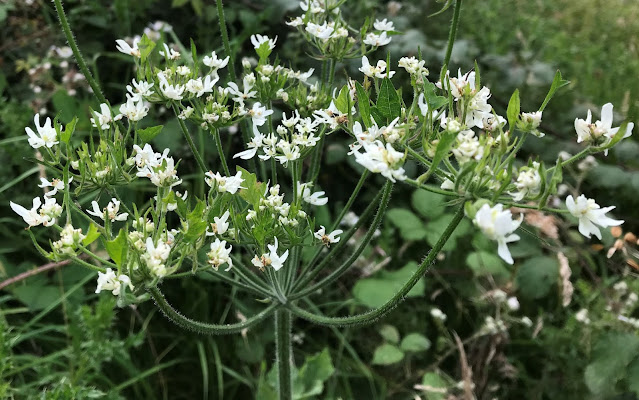Back in late winter (just before the year took a strange turn) I found a large stand of an unusual looking Arum under trees along an old track near Mickletown (VC63). It was in full leaf and yet there were no others around either here or locally, which struck me as odd. It seemed far too early for Lords-and-Ladies (Arum maculatum) to be both up and so far advanced. My gut feeling was it had to be the unmarked form of Italian Lords-and-Ladies (Arum italicum subsp. neglectum) but I wanted to see it in flower to be sure, something I was not able to achieve despite regular trips over spring and early summer (frustratingly, come October I realised it must have flowered as there was one fruiting stem). The leaves looked a good match to some images online but not enough for me to be certain. Perhaps relevant to this, I later found out that early season foliage differs in shape from late season foliage. The following photos were taken in April 2020 once Lords-and-Ladies had emerged, the pale veins of the Italian Lords-and-Ladies were quite obvious when compared against the former.


With that in mind, the next thing to do was go and look for it this autumn, as this would clinch the identification. So in October with the marked form of Italian Lords-and-Ladies (Arum italicum subsp. italicum) popping up all over the place I went for a look. Annoyingly there was no trace, but all was not lost as subsp. neglectum is reputed to emerge later than subsp. italicum. By the time of my second trip in early November it was just emerging. A good result, case closed.
The only remaining question is how did it get there? Yorkshire is far outside its native range. While it could be an escape from cultivation it is a relatively obscure one, even in a county with more than its fair share of unusual escapes - if it can be grown in Yorkshire you can be certain someone is somewhere! I can't think why anyone would specifically choose this species, short of there being an Aroid fanatic living in Mickletown. There is perhaps a slim possibility that it came in with daffodil bulbs originating from a grower in South-West England, as the margins of this track support a diverse mixture of old fashioned cultivars in the spring. Certainly the size of the clump indicates it has been there for a number of years, perhaps decades.
Last photo taken November 2020
I had to wait until September 2020 for my next unusual Arum, when this clump was well advanced at Ouzlewell Green (VC63). Clearly it has a relationship to the marked form of Italian Lords-and-Ladies, but the leaf shape is not typical, nor is the yellow-tinged venation. I'm going to keep an eye on this, and again try to see in flower, but at present I think it can only be a hybrid will Lords-and-Ladies.
















